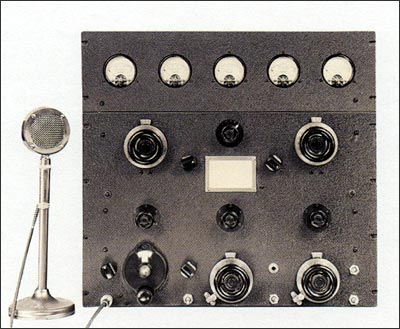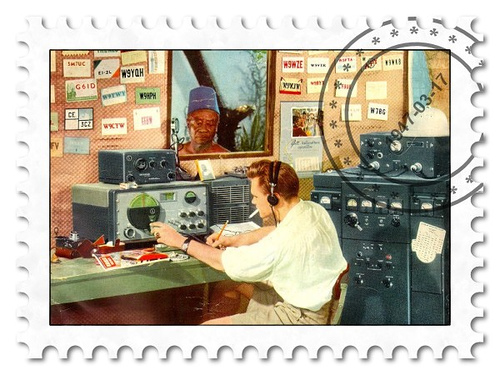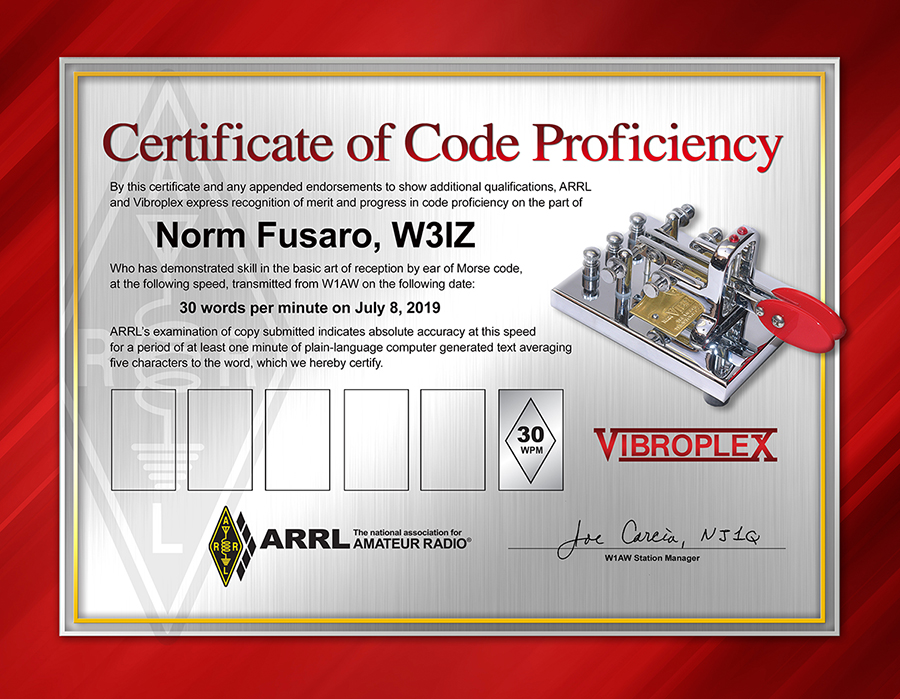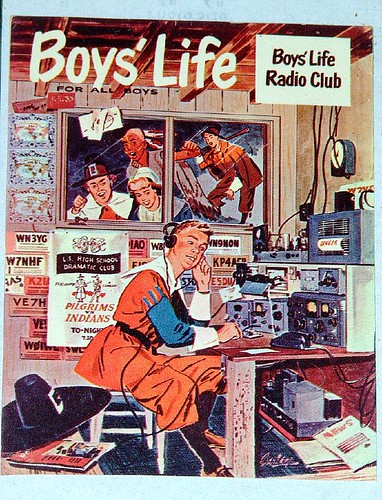Category: radio
Locked on and plugged in
After a painful few weeks of being off the internet, we are now back online through a satellite internet service.
During the internet outage, MARS Winlink/Airmail worked like a champ – allowing me to stay in contact with friends and family. I am impressed with the reliability of WL2K.
Iraq to Be Back on the Air
Iraq to Be Back on the Air Later This Month (Nov 13, 2007) — Diya Sayah, YI1DZ, President of the Iraqi Amateur Radio Society (IARS), announced today that effective November 20, all Amateur Radio activity will be “back to normal” in Iraq. Sayah said, “All Amateur Radio operators in Iraq who carry a valid Iraqi license will be able to use their radios according to regulations of IARU Region 1 and the IARS.” Amateur Radio activity in Iraq was suspended in March of this year, with the suspension affecting both Iraqi citizens as well as any foreigners — including military personnel and contractors — who have been on the air from Iraq. The request to halt all ham radio activity and the issuance of licenses in Iraq originated with a letter from the Iraqi Ministry of Defense to Iraqi Prime Minister Nouri al-Maliki as part of a new security plan, Sayah said.
The truth hurts
I enjoyed this email from the Second Class Operators’ Club reflector….
To: Second Class Operators’ Club
Subject: [SOC] The truth hurts
I’m still recovering from a nearby lightning strike that came up phone line to fry DSL modem, all the I/O ports on an aging 386 PC and miscellaneous pieces of ham gear. XYL and son decreed that new computer would be early Christmas present. After much consideration, decided on an iMac, also running XP with Parallels. [a separate discussion for those who care]. This has required a truly second class fumbler to learn a totally unfamiliar operating system while restoring various hardware/software items from the previous incarnation, referred to in the family as “vocabulary enrichment opportunities.”
One such item is the WinKey keyer that requires DB9 serial input, not yet knowing if it is also fried. Ah, but the iMac has only USB ports. So USB-serial adapter was needed and ordered online at great saving compared to local purchase. It arrived with drivers on a 2.5 inch CD. That’s a neat idea for PCs with horizontal CD drive (aka coffee cup holder), but useless on the iMac with vertical slot in side. This has led to another series of second class misadventures. Somewhere along the way, I asked guru son about identifying the port assigned when connecting serial adapter for WinKey. His classic reply repeated below.
“Lessee, you have a new Mac with latest technology so you can get away from Microsoft, but you have to run Windows on it (part time) so you can use some specific Windows-only software and you need USB-serial adapter to operate a gizmo to control a transmitter that you could otherwise turn on and off with a simple hand key using a serial binary code that’s 160+ years old.”
I think this is the point where I should revert to a manual digital mode and give him the finger.

The Review, Part 2: The World of Ham Radio, 1901-1950: A Social History
Read part 1 of the review here
This was a book I hated to finish reading. Chapters 9 – 12 are full of amateur radio’s involvement in aviation, sea journeys, and the exploration of the polar regions. There is great coverage of the private schooner Yankee, which sailed around-the-world with a crew made up of college age young men and stops included the Galapagos Islands, Easter Island, Pitcairn (a fascinating story there), Manga, and Tahiti. Alan Eurich, W8IGO, worked the onboard rig and was an invaluable member of the crew. Chapter 10 talks about an amazing air race between Oakland, CA and Hawaii – amateur radio played a key role in tracking the planes and providing help. Anne Morrow Lindbergh operated a rig when flying with her husband, making contacts with many amateurs. The most interesting of the Antarctica explorations involved radio operator Sidney Jeffryes who’s isolation and resulting insanity jeopardized the mission… sending crazed reports back to Australia via Macquarie Island. Almost all the major polar expeditions used radio. QST covered almost all these adventures, sparking the imagination of young hams back home.

Chapter 13 covers amateur radio’s involvement in supporting emergency and disaster response. Flooding, hurricanes, and fire – hams responded and used their radios to help the authorities organize their efforts as well as to pass health and welfare traffic. The forest service was also instrumental in the development of portable radio with the help of dedicated amateurs.

Chapters 14 and 15 cover the neutrality period prior to WWII, WWII itself, and the early post-war years. QST encouraged those hams enlisting in the service to bring along their FCC license and push to be placed in a signal organization to take advantage of their skills.
The World of Ham Radio, 1901-1950: A Social History is a great book, well written, entertaining, and enlightening as to the roots of amateur radio in the US. I highly recommend this book to anyone who is interested in the history of ham radio and the individual hams who have contributed so much in the early years.
High-tech culture of Silicon Valley originally formed around radio
Tom Abate, Chronicle Staff Writer
Sunday, September 30, 2007
They weren’t out to make history, the eight young engineers who met secretly with investor Arthur Rock 50 years ago to form Silicon Valley’s ancestral chip company, Fairchild Semiconductor.
The men, among them future Intel co-founder Gordon Moore, mainly wanted to escape their brilliant but batty boss, William Shockley, who had just shared the 1956 Nobel Prize in physics for his role in the invention of the transistor.
Shockley, who had started a company in Mountain View in 1955 to commercialize this breakthrough, had bullied and browbeaten his young engineering staff, whose numbers included future venture capitalist Eugene Kleiner, at 32 the oldest of the bunch; the rest of the renegade group were younger than 30.
So when the Traitorous Eight, as they’re sometimes called, held their hush-hush meeting in San Francisco, they had reason to fear discovery – but no way to know that by quitting safe jobs for a risky startup, they would earn a place among what Stanford University historian Leslie Berlin calls the “Founding Fathers of Silicon Valley.”
But wait. The National Register of Historic Places recognizes the garage in Palo Alto where David Packard and William Hewlett started their company. Isn’t that the birthplace of Silicon Valley?
And here’s a hitch. Not until 1971 was “Silicon Valley” used to describe the concentration of chip-making firms in the South Bay.
So what is Silicon Valley? How and when did it arise? And most important, perhaps, what is the future of this region that has become a synonym for innovation?
“There is this myth that Silicon Valley was all orchards when the chip companies arrived, but it’s not true. It had been building, building for a long time,” said Christophe Lécuyer, a Stanford-trained historian who turned his dissertation into a book, “Making Silicon Valley.”
Lécuyer, now an economic analyst with the University of California system, said the region’s technological awakening began almost a century ago when, not long after the great quake of 1906, the Bay Area – and particularly the Peninsula – began innovating with the then-hot technology of radio.
“The San Francisco Bay Area was a natural place for interest in radio because it was a seagoing region,” said Timothy Sturgeon, an industrial researcher at the Massachusetts Institute of Technology who described this radio period in a paper, “How Silicon Valley Came to Be.”
Lécuyer and Sturgeon argue that, roughly 30 years before Hewlett and Packard started work in their garage, and almost 50 years before the Traitorous Eight created Fairchild, the basic culture of Silicon Valley was forming around radio: engineers who hung out in hobby clubs, brainstormed and borrowed equipment, spun new companies out of old ones, and established a meritocracy ruled by those who made electronic products cheaper, faster and better.
As Sturgeon notes, as early as 1909, Stanford graduate Cyril Elwell was acquiring patents for new radio technologies and persuading university officials, including then-President David Starr Jordan, “to finance a new company” in Palo Alto that would be called Federal Telegraph Co.
That same year in San Jose, Charles Herrold started a school for radio engineers and began broadcasting to radio hobbyists and later to a small local audience to become what a 1994 PBS documentary called “Broadcasting’s Forgotten Father.” Back then, the region had none of its present cachet relative to other clusters of radio activity like New York, New Jersey and Boston.
But in this rivalry with the industrial powers of the East, the future Silicon Valley would find a powerful customer with deep pockets – the U.S. military.
Sturgeon said U.S. naval officials, impressed by Federal Telegraph’s technology, gave the Palo Alto firm huge contracts during World War I – the first but not the last time war would fuel the region’s tech firms.
In another hint of the future, Sturgeon writes that around 1910, Peter Jensen and Edwin Pridham quit Federal Telegraph “to start a research and development firm in a garage in Napa” to improve loudspeakers. In 1917, they formed Magnavox, which built public address systems for destroyers and battleships in World War I.
The war’s end took the wind out of Silicon Valley’s sails. The Eastern radio powers, notably RCA, dominated the field during the 1920s and 1930s. The region’s entrepreneurial fire cooled but, as history would show, didn’t die.
Creation story
The next chapter in the Silicon Valley story involves the familiar tale of how Hewlett and Packard hatched the region’s first technology giant in a Palo Alto garage.
Sophisticated versions of this creation epic also credit their mentor, Stanford engineering Professor Frederick Terman.
Terman, who began teaching at Stanford in the late 1920s, would spend the rest of his career formalizing the university-industry collaboration that would come to typify Silicon Valley.
But in the hardscrabble ’30s, it was all Terman could do to hold together the ecosystem of tinkerers and researchers who were trying to survive the Depression.
He had help from tech pioneers such as Charles Litton Sr., who in 1932 established a machine shop that made better vacuum tube manufacturing tools. Tubes were the workhorse of electronics before transistors and – according to Lécuyer – Litton’s tools allowed San Bruno vacuum-tube-maker Eitel-McCullough to build superior components – and a reputation.
Another seminal event was the 1939 invention of the klystron tube by Stanford research associates and brothers Russell and Sigurd Varian, who would later start Varian Associates. The klystron tube led to more powerful radars, helping the United States and its allies gain an advantage in World War II.
In his 1995 memoir, “The HP Way,” Packard himself provides a glimpse of this ecosystem in action, telling how Terman arranged for him to work evenings at Litton’s shop.
“Charlie Litton had started with the Federal Telegraph Company in Palo Alto,” Packard wrote, adding, “My relationship with Charlie developed into a long and enduring friendship.”
Garage-era Silicon Valley also adopted the business model of the radio age – supplying the U.S. armed forces.
“Military funding was critical for the rise of Silicon Valley from the very late 1930s to the early 1960s,” Lécuyer said. For instance, he said, Eitel-McCullough had about 15 people making vacuum tubes before the war. That swelled to 4,000 employees in 1943, then contracted to 200 in 1945, when peace crippled demand for tubes.
So, by the time the Traitorous Eight started Fairchild, the recipe for Silicon Valley largely had been written. Still, the notion that they founded the valley is justified by what financier Rock brought to the party – the money to bankroll bold engineers.
“The venture capital sector really arises along with the semiconductor industry,” Lécuyer said. “Once the venture capital is in place, it makes all the other things possible.”
From Fairchild forward
Investment that rewards risk became the final catalyst for the Silicon Valley we know, where ideas, nourished by money, spawn startups, products, even whole industries, like biotechnology.
The first big wave of startups created by venture investment were the dozens of Fairchildren – chip companies like National Semiconductor, Advanced Micro Devices and Intel – started by engineers who traced their ancestry to the Traitorous Eight.
Intel became the largest of these Fairchildren, and Moore the best known of the eight. But the gang leader was his charismatic colleague Robert Noyce. A technical innovator – in this meritocracy he had to be – in 1961, Noyce designed the first chip that enabled two transistors to work together on a single slice of silicon. Called the “integrated circuit,” it is the ancestor of today’s billion-transistor chips.
In 1971, when trade press reporter Don Hoefler used “Silicon Valley” to describe the concentration of chip-making firms on the Peninsula, the name stuck. But almost from the start, it stood for more than chip-making.
“Silicon Valley created an environment that allowed ideas and money and people to combine more easily,” said AnnaLee Saxenian, dean of the School of Information at UC Berkeley and an expert on the region.
The early chip industry, like the two waves of innovation before, initially depended on military expenditures, Paul Ceruzzi, a curator at the Smithsonian Institution, writes in his book “A History of Modern Computing.”
Only this time, it was the Cold War that opened the government’s checkbook.
The Soviet launch of Sputnik on Oct. 4, 1957, prodded the United States to modernize its missile and space program. The newfangled silicon chips were considered vital – albeit costly – components, and Ceruzzi writes that NASA and the Defense Department bought so many “that the price dropped from $1,000 a chip to between $20 and $30.”
Falling chip prices fueled development of new electronics for corporate customers and eventually individual consumers. Reliance on military purchases lessened, though defense dollars remained important in spurring research. Thus, when Larry Page and Sergey Brin later dreamed up Google, a defense research grant helped support their work. And when Stanford computer scientists won a robotic car race in 2005, the prize came from the Defense Department.
By the 1970s, therefore, Silicon Valley was poised to capitalize on new civilian technologies like PCs, as exemplified by Apple Computer.
In the 1980s, excitement shifted to scientific workstations and networking devices from firms like Sun Microsystems and Cisco Systems, and to software like the version of UNIX perfected at UC Berkeley.
In the 1990s, the point-and-click browser popularized by Netscape ignited the dot-com boom and, after a painful bust and slow recovery, the recent rise of Google and social networking sites such as Facebook signal another wave of entrepreneurship.
Back to the future
Today, Silicon Valley is showing signs of age. Traffic is bad. Housing is worse. And it’s competing with every metropolitan region in the nation – indeed, the world.
Saxenian, the Berkeley dean, is optimistic. Her most recent book, “The New Argonauts,” posits that Silicon Valley will remain a design and innovation center by partnering with lower-cost manufacturing centers overseas.
“Viewed from outside the United States, Silicon Valley is an amazing place,” she said. “I’d put my bets on innovation coming out of the valley for the next 20 years.”
But jobs are a concern. Tech employment hasn’t yet recovered from the dot-com bust. The American Electronics Association says California had 1.2 million tech jobs in 2000. Its most recent snapshot found 280,000 fewer Californians collecting high-tech paychecks.
Is it outsourcing? Is it globalism? Is it a problem? Maybe the answer depends on whether you’re looking for work or looking to hire.
And more to the point, after all this time, do we know what Silicon Valley is, or better yet, how to keep it vital?
“My biggest hope for the valley is that we continue to have the focus, creativity and capital to reinvent our future and the future of technology,” said Paul Otellini, CEO of Intel Corp., the most prosperous of the Fairchildren.
“My biggest fear is that we will get complacent and allow it to happen elsewhere.”
Amateur Radio Goes to Washington
from The ARRL Letter, Vol 26, No 39
Army MARS Chief Stuart S. Carter, AAA9A, has invited the ARRL and Amateur Radio representatives to join a Military Affiliate Radio System (MARS) demonstration outside the Capitol building in Washington, DC on October 3. Hams around the country are asked to aid in the demonstration by making HF contacts during the day. With help from Laura Abshire, Legislative Aide to Representative Mike Ross, WD5DVR (D-AR), Tricia Russell, Legislative Aide to Representative Steve Israel (D-NY), and coordination of the myriad details by “Pudge” Forrester, W4LTX, Systems Administrator for Representative Roscoe Bartlett (R-MD), the “show” is set for next Wednesday, and hams around the country can help.
ARRL Media and Public Relations Manager Allen Pitts, W1AGP, said, “Thanks to a MARS invitation to join in a demonstration, and excellent coordination work by Forrester, the October 3 demonstration of Amateur Radio and MARS emergency communications will be front and center in the open space between the Capitol building and the Botanic Garden in Washington, DC.” Pitts went on to say that the regional MARS organization is planning to conduct an exercise demonstrating emergency communications at the Capitol, as well.
The exercise assumes a Category 3 hurricane, Hurricane Quincy, will make landfall on October 2 over the coastal areas of Delaware, Maryland, DC and Virginia. Quincy will progress northward to New Jersey and Pennsylvania and then travel inland to the south, returning to the Atlantic Ocean on October 5 via the Carolinas and Georgia. During this time, MARS resources will be challenged by ongoing events in every part of the country, including ice storms, tornadoes, severe thunderstorms, and earthquakes.
There will be a communication trailer, tent type shelter, four HF transceivers — voice, PSK, and Winlink — and VHF equipment at the site. The local Voice of America (VOA) organization and MARS have local repeaters and digipeaters available. Power will come from solar panels and generators with battery backup. The emergency communications trailer, owned by the Blue Ridge Association, Baptist Convention of Maryland/Delaware, part of the Southern Baptist North American Missions Disaster Relief Ministries, will also be on hand.
Representatives from ARRL headquarters, including Pitts, will be there. They will have ARRL public relations materials as well as video that shows the negative impact of BPL if current FCC rules are not modified. In addition, there are special materials for Members of Congress and their staff advocating Amateur Radio’s positions on several legislative issues, including information to solicit co-sponsorship of H.R. 462 and H.R. 2743.
While MARS will be conducting their drill on their frequencies, Amateur Radio operations are scheduled from 1400-2100 UTC. While there may be last minute changes, plans are to try to center HF voice contacts around 14.250 and 7.250 MHz, and on PSK at 14.070 MHz. “By showing Members of Congress our nationwide capabilities and potentials, we advance the Service in many ways,” Pitts said.
Representatives Ross and Bartlett plan to stop by. Army MARS is sending their Chief of Operations Grant Hays from Arizona. Mike Barrett, K3MMB, of the Transportation Security Administration’s Office of Security Operations is aiding with the operations and logistics.
The Review, Part 1: The World of Ham Radio, 1901-1950: A Social History
This is a modern telling of Clinton DeSoto’s 1936 classic 200 Meters and Down story through meticulous research of the author, Richard Bartlett, and the amateur radio experiences of the his brother Forrest, W6OWP. Tracing the start of radio from Marconi through the emergence of a thriving hobby in the post WWI years, Bartlett does a wonderful job of taking the reader on a journey through the history of ham radio. It is a more vibrant story than 200 Meters, aided by hindsight and a wealth of primary sources the author pulls from. When he describes the early boy-ham experimenter, I immediately drew a parallel with the boy-“hackers” of the 1980s and 90s. Teenage boys, curious and prone to mischief with knowledge of a new technology unfamiliar to most. Ignorance easily creates fear, and these early boy-hams were often looked at as a danger and a threat.

There is good coverage of the early organizations supporting ham radio to include The Royal Order of the Wouff Hong. I’d always heard about the Wouff Hong and it was fascinating to read about it’s humorous origins.
Bartlett covers many of the highlights of ham radios initial contributions: demonstrating the ability to relay messages across the country, providing a means of communications in support of disaster areas, and sending messages across the globe. It is amazing that amateur radio survived the post-WWI years – threatened by both the military and commercial broadcast interests. The hobby also created a commercial industry of amateur radio equipment suppliers – Bartlett describes the elaborate displays these businesses put on at the Chicago’s 1933-34 World’s Fair that helped capture the imagination of the public.
The best part of the book so far is Bartlett’s coverage of ham radio’s support to exploration in the 1920s and 30s (Chapter 7, Amateurs as Experimenters and Adventurers). Harry Wells, W3ZD, accompanied a 1929 scientific expedition to Borneo and sent reports back to hams in the states. Bertram Sandham, W6EQF supported an automobile expedition to open up an International Pacific Highway from Fairbanks, AK to Buenos Aires. The descriptions of both these portable and mobile operations are exciting and inspiring.

I’m still working through the book, so more to come.
… part 2 of the review is here
The World of Ham Radio, 1901-1950: A Social History

Just started this book by Richard Bartlett, The World of Ham Radio, 1901-1950: A Social History. It focuses on the early years of amateur radio and the development of radio technology. So far it is a great read. I’ll write up a complete review when I’m finished.
CW Practice
I’m continuing to try and improve my CW skills – primarily my ability to copy. Now I’m working with the MFJ-418 Morse Code / CW Tutor.

There’s a lot this little box does. It looks a little like the pager I used to carry in the mid 1990s. I was first introduced to this device by John, KE4UP. He hosted (along with Don, N4DJ) a CW class I participated in back in November/December of 2005. I had recently passed my 5 WPM test but wanted to get better at CW. During one of the sessions John brought in his CW Tutor and said it had really helped him. It is easy to use, easy to change the speed the code is sent. It will even send practice QSOs to copy. My goal is to pass the ARRL Code Proficiency at 25 WPM. I have a ways to go.


